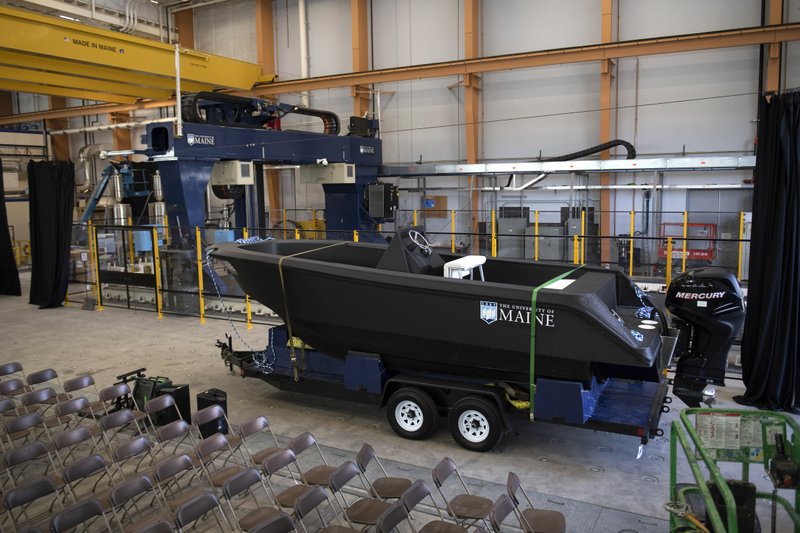The world's largest 3-D printer has created the world's largest 3-D printed boat. And the University of Maine demonstrated Thursday that it's seaworthy.
The university unveiled the 25-foot, 5,000-pound boat that was printed at the university's Advanced Structures and Composites Center. It's one example of how the huge 3-D printer can create larger prototypes to assist companies in product development, said Habib Dagher, founding director of the composites center.
"This new printer is going to allow us to innovate so much faster by having prototypes made faster than in the past," Dagher said.
U.S. Sen. Susan Collins, R-Maine, christened the boat by smashing a bottle of Champagne on its bow at the event in Orono. Later, she and U.S. Sen. Angus King, I-Maine, climbed aboard for a demonstration in the university's W2 Wave-Wind basin "ocean simulator," which looks like a giant indoor swimming pool.
The boat is named 3Dirigo, a play on Maine's motto, "Dirigo," which is Latin for "I lead."
The printer, also unveiled, is currently 70 feet long and will grow to 100 feet with an extension, Dagher said. The university and the Oak Ridge National Laboratory in Tennessee are collaborating on the printer project.
"This a big deal. This is probably the biggest day for this university since Stephen King matriculated in 1965," King joked, referring to the best-selling author who graduated from the school.
The 3-D printer, which can gobble up 500 pounds of plastic polymer pellets per hour, is already proving useful as demonstrated by the patrol boat.
But the university hopes to make it better.
A $20 million research collaboration with the Oak Ridge lab will focus on using bio-based thermoplastics reinforced by cellulose-based materials to create a 3-D printable material that's strong, durable and recyclable, Dagher said. If it works according to plan, the printer will be able to quickly produce items like molds for boats or concrete casks that could be recycled afterward, he said.
The composites center also received $500,000 from the Maine Technology Institute to help Maine boat builders explore how large-scale 3-D printing can provide the industry with a competitive advantage.
The printer itself cost $2.5 million with additional funding going toward installation, commissioning, and material testing, with most of the funding provided by the Army.
Joining Collins, King and U.S. Rep. Jared Golden, D-Maine, at the event were more than 250 industry, military and government representatives.
In addition to the boat, the university used the printer to create a mold for a bridge girder and a communication shelter for the Army.
As for the boat, it was the first thing printed by the university, and it was created in one solid piece during a nonstop printing over 72 hours. It cost about $40,000 to produce.
Guinness World Records confirmed it's the world's largest 3-D printed boat, the largest 3-D printed object and the printer is the largest prototype polymer 3-D printer, the university said.
Business on 10/11/2019
